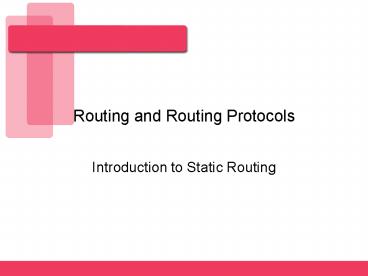Routing and Routing Protocols - PowerPoint PPT Presentation
1 / 25
Title:
Routing and Routing Protocols
Description:
Routing and Routing Protocols Introduction to Static Routing Routing Decisions Routing is the process that a router uses to forward packets toward a packet s ... – PowerPoint PPT presentation
Number of Views:374
Avg rating:3.0/5.0
Title: Routing and Routing Protocols
1
Routing and Routing Protocols
- Introduction to Static Routing
2
Routing Decisions
- Routing is the process that a router uses to
forward packets toward a packets destination. - Routing decisions are based on the destination IP
address of a packet.
3
Routing Methods
- Routers must learn the direction to remote
networks in order to forward packets. - Two ways to learn this information
- Dynamically
- Information is learned from other routers
- Often through RIP, OSPF, or EIGRP routing
protocols - Statically
- Configured manually
- Requires the network administrator to add and
delete static routes when topology changes - In large networks it requires a tremendous amount
of administrative time - On small, or unchanging networks, it requires
very little maintenance
4
Static Route Operation
- Static route operations can be divided into 3
stages - A network administrator manually configures the
static route on the router - The router installs the route in its routing
table - Packets are routed using the static route
5
Configuring Static Routes
- Send traffic through an interface
- Send traffic to the next routers address
6
Configuring the Outbound Interface
7
Configuring the Next-Hop Address
8
Routes and Interfaces
- If a router cannot reach the outgoing interface
that is being used in a route, the route will not
be installed in the routing table. - This means if that interface is down, the route
will not be placed in the routing table.
9
Administrative Distance
- The administrative distance is a number that
measures the trustworthiness of the source of the
route information. - The lower the administrative distance, the more
trustworthy the source. - If a path has the lowest administrative distance,
it is installed in the routing table.
10
Default Administrative Distances
11
Multiple Routes to the Same Destination
- When two or more routes point to the same
destination, the administrative distance is used
by the router to determine which route is entered
into the routing table. - All routes are remembered, but only the best
route makes it into the routing table.
12
Static Routes as Backups
- Often static routes are used for backup purposes,
such as when the dynamically learned route fails.
13
Backup Route Example
- For Router0, the preferred path to the
192.168.0.0 network is through the switch. - If RIP is used to exchange routes between the two
routers, this route will be marked as the best.
No Routing Protocol
192.168.0.0/24
192.168.2.1
192.168.2.2
192.168.1.2
192.168.1.1
14
Router0 Routing Table
No Routing Protocol
192.168.0.0/24
192.168.2.1
192.168.2.2
192.168.1.2
192.168.1.1
15
Backup Route Creation
No Routing Protocol
192.168.0.0/24
192.168.2.1
192.168.2.2
- To configure a static route for the 56 kbps
backup serial line
192.168.1.2
192.168.1.1
16
Router0 New Routing Table
No Routing Protocol
192.168.0.0/24
192.168.2.1
192.168.2.2
- Now, the static route shows up in the routing
table, instead of the better route learned
through RIP.
192.168.1.2
192.168.1.1
17
Fixing the Routing Table Problem
No Routing Protocol
192.168.0.0/24
192.168.2.1
192.168.2.2
- RIPs default administrative distance is 120.
- Creating the route with an AD higher than 120
will ensure the RIP route is placed in the
routing table.
192.168.1.2
192.168.1.1
18
The Backup Route In Action
No Routing Protocol
192.168.0.0/24
192.168.2.1
192.168.2.2
- When the RIP-learned route is unavailable, the
static backup route is placed in the routing
table.
192.168.1.2
192.168.1.1
19
The Backup Route In Action
No Routing Protocol
192.168.0.0/24
192.168.2.1
192.168.2.2
- Once the better route is available, the RIP route
will be re-entered into the routing table,
automatically.
192.168.1.2
192.168.1.1
20
Configuring Default Route Forwarding
- Default routes are used to route packets to
destinations that do not match any of the other
routes in the routing table. - A default route is a special static route that
uses the quad-zero format - ip route 0.0.0.0 0.0.0.0 next-hop-address
outgoing interface - If the packet does not match a specific route in
the routing table, it will be routed to the
0.0.0.0 network. - Any IP address will always yield the network
address 0.0.0.0 when ANDed with the mask 0.0.0.0.
21
Default Routing Example
- In this example, no routing protocol is used.
- Instead, a default route will be used to allow
Router0 to direct traffic to the ISP router.
No Routing Protocol
192.168.0.1
192.168.0.2
10.0.0.1
10.0.0.0/24
22
Router0 Routing Table Prior to Default Route
No Routing Protocol
192.168.0.1
192.168.0.2
- Router0 can see the two directly connected
networks and cannot route traffic to the Internet.
10.0.0.1
10.0.0.0/24
23
Adding a Default Route
No Routing Protocol
192.168.0.1
192.168.0.2
- Entering the quad-zero route on Router0 allows
the router to send all remote traffic to the
next-hop.
10.0.0.1
10.0.0.0/24
24
Viewing the Default Route
No Routing Protocol
192.168.0.1
192.168.0.2
- Entering the quad-zero route on Router0 allows
the router to send all remote traffic to the ISP.
10.0.0.1
10.0.0.0/24
25
Default Route Note
- The routers on the Internet must have a route in
their routing tables that points to Router0 (or a
default route that accomplishes the same). - Otherwise, Router0 will be able to route traffic
to servers on the Internet, but the Internet
routers would not be able to route the responses
back to Router0.
No Routing Protocol
192.168.0.1
192.168.0.2
10.0.0.1
10.0.0.0/24































